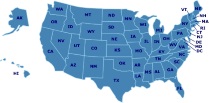How Do Learning Styles Work in the Homeschool Environment?
Understanding Your Child's Learning Style
Homeschooling Students With Different Learning Styles (Visual, Read/Write, Auditory and Kinesthetic)
Do you know how your child learns best? If you're not sure, this guide can help you figure it out. Because people learn in different ways, with diverse ways of capturing information and processing knowledge, you'll be more successful in your homeschooling if you can understand these particular learning styles for your children. Responding to your children's learning styles will help both them and you become more effective and enthusiastic about learning in your home. This guide helps you understand visual learning styles, auditory learning styles, reading/writing learning styles, kinesthetic learning styles, and offers information and tips to get the most out of your understanding of your own child.
Know Your Students: Identify Their Personal Learning Styles
How to Homeschool: Determine Your Child’s Learning Style
One of the first steps you should take when embarking on homeschooling is determining your child's learning style. Most people tend towards one of the four main learning styles. This means that they are more successful in learning when the learning and teaching corresponds to this style. Few people are only one learning style, so exploring the different styles is helpful. This guide details four learning styles: kinesthetic, visual, auditory, and tactile.
For the Learners' Sake: Brain-Based Instruction for the 21st Century
Right-Brained Children in a Left-Brained World: Unlocking the Potential of Your ADD Child
The Seven Learning Styles
Learning Styles: Reaching Everyone God Gave You to Teach
7 Tips for Homeschooling Different Learning Styles
This explanation guide details the seven different learning styles: visual, auditory, kinesthetic, linguistic, logical, solitary, and social. People usually are a combination of more than one learning style. Implementing teaching and learning methods to respond to these styles can benefit homeschooling. These tips will help you integrate an understanding of learning styles into your homeschooling.
In Their Own Way: Discovering and Encouraging Your Child's Multiple Intelligences
Learning Styles and Hemispheric Dominance—Right or Left Brain: Which is Dominant in Your Family?
How to Determine Your Child's Learning Style
Learning Styles: Reaching Everyone God Gave You to Teach
In Their Own Way: Discovering and Encouraging Your Child's Multiple Intelligences
Quiz: What's Your Child's Learning Style?
Knowing and understanding your child's learning style is the key to homeschooling success. This short quiz will help you determine what ways of learning are best for your child.
How to Determine Your Child's Learning Style
Children process information and learn in different ways. There are three primary ways in which people learn: visual, auditory, and kinesthetic. When you discover how your child learns, you can help shape their educational experience to prioritize this primary learning style, while also ensuring a well-rounded education.
The Way They Learn
Discover Your Children's Gifts
This comprehensive work on children's learning styles and creativity expression is a tremendous help to parents as they begin homeschooling. The authors discuss how God gifts children in different ways with different ways of learning and expression. This guide will help you identify your child's personality gifts and help them reach their full potential.
Discover Your Child's Learning Style : Children Learn in Unique Ways - Here's the Key to Every Child's Learning Success
Determining Your Child's Learning Style
Most students use a combination of learning styles, drawing from the four main types: visual, auditory, reading/writing, and kinesthetic. Responding with the right approach to your child's learning style can make all the difference when it comes to your child learning, understanding, and remembering educational material. With understanding of your child's learning style, you can more effectively choose materials and methods to emphasize his or her strengths rather than work against them.
How To Identify Children’s Learning Styles
An appreciation of your child's primary learning style will help you support them in learning at home. It is also important to understand your own learning style if that is different from your child's. First, identify your own learning style of one of the four primary types: visual learner, kinaesthetic learner, auditory learner, and logical learner.
The Learning Style Quiz
How do I know what my child's learning style is? This quick quiz can help you figure it out. There are lots of combinations of different learning styles and usually children are not just one single style. Everyone learns in a variety of ways. Understanding this can help you re-evaluate and adjust to your child's particular learning style. This quiz focuses on the three main learning styles: auditory, visual, and kinesthetic.
Featured Resources
As an Amazon Associate, we earn from qualifying purchases. We get commissions for purchases made through links on this site.










